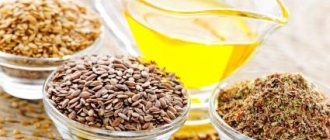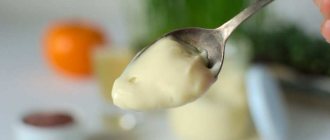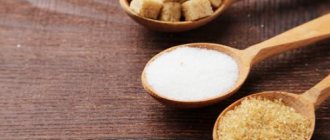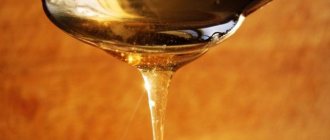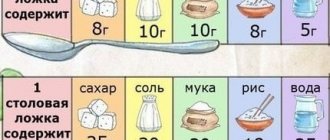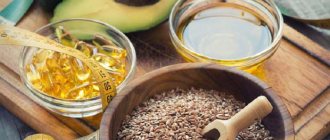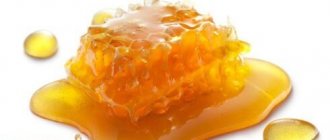Good afternoon, today we will tell you how many calories are in 1 spoon of sugar. This is very necessary information for those people who care about their health. Not everyone can boast of a figure and a healthy body, but the most important thing is proper nutrition. Sugar is produced in all countries of the world, but is made from different raw materials. Sugar can be made from sugar beets, pumpkins, cane, corn and grapes. But despite the fact that sugar is produced differently, the number of calories is approximately the same 1 gram of sugar = 4 calories. In order to find out how many calories are in one or two spoons of sugar, you need to know the weight of a spoon of sugar. You can read this in our article, how many grams of sugar are in a spoon.
How many calories are in sugar?
The topic of sugar's calorie content is not as clear-cut as it seems. Despite the fact that one gram of any type of sugar (both the cheapest refined sugar and organic coconut sugar) contains about 4 kcal, the human body uses these calories in a completely different way. Ultimately, a teaspoon of honey or coconut sugar is not the same as a cube of table white sugar.
Essentially, what matters is not how many calories are in that teaspoon of sugar, but how the body can use those calories. For example, calories from processed fructose sugar syrup will go into fat stores much faster than calories from natural cane sugar - and neither color (white or brown) nor taste play much of a role.
Sugar calories per teaspoon
If you are used to drinking tea or coffee with sugar, remember that a level teaspoon of sugar contains approximately 20 kcal, and a heaped teaspoon of sugar contains about 28-30 kcal. Unfortunately, when you add two full tablespoons of white table sugar to your coffee, you're not just adding 60 calories to your daily diet - you're dramatically switching up your metabolism.
Once in the stomach, sugar dissolved in liquid is absorbed as quickly as possible and enters the blood in the form of glucose. The body understands that a quick source of energy has appeared and switches to using it, stopping any fat-burning processes. However, when the calories of this sugar run out, “withdrawal” begins, forcing you to drink sweet tea again and again.
Which sugar is the healthiest?
Despite the fact that all types of sugar have the same calorie content, their glycemic index is quite different. Essentially, white refined sugar is absorbed by the body about twice as fast as brown coconut sugar, causing first a sharp spike in blood glucose levels and then a decrease in these levels. The main reason lies in the processing processes.
In simple terms, bee honey, coconut sugar and cane sugar can be considered natural products because they are made using predominantly mechanical processes - unlike refined sugar obtained from sugar beets. It requires multi-step chemical reactions to make, including heating and bleaching.
Types of sugar: glycemic index
| Name | Type of sugar | Glycemic index |
| Maltodextrin (molasses) | Starch hydrolysis product | 110 |
| Glucose | Grape sugar | 100 |
| Refined sugar | Sugar beet processing product | 70-80 |
| Glucose-fructose syrup | Corn processing product | 65-70 |
| Cane sugar | Natural product | 60-65 |
| Bee Honey | Natural product | 50-60 |
| Caramel | Sugar processing product | 45-60 |
| Lactose | Milk sugar | 45-55 |
| Coconut sugar | Natural product | 30-50 |
| Fructose | Natural product | 20-30 |
| Agave nectar | Natural product | 10-20 |
| Stevia | Natural product | |
| Aspartame | Synthetic substance | |
| Saccharin | Synthetic substance |
Table of calorie content and nutritional value of different types of sugar
| Name | Calorie content | BZHU for 100 g | ||
| Squirrels | Fats | Carbohydrates | ||
| White (refined) sugar | 398 | 0 | 0 | 99,7 |
| Cane sugar | 385 | 0,21 | 0,04 | 97,61 |
| Coconut sugar | 376 | 1,1 | 0,5 | 94 |
Is brown sugar healthy?
It is necessary to understand that it is not just the color and shape of a certain type of sugar that plays a role, but whether the original product has been chemically processed. The modern food industry can easily give a dark color and a pleasant aroma to highly processed sugar from cheap sugar beets or sugar cane residues - it's just a matter of marketing.
On the other hand, natural coconut sugar, which has a lower glycemic index, can be bleached through gentle processes - as a result, it will look like regular refined sugar and contain the same number of calories per teaspoon, while at the same time having a fundamentally different mechanism of action on metabolism a specific person.
Are sweeteners harmful?
In conclusion, we note that sugar creates addiction not so much at the hormonal level as at the level of taste. Essentially, a person gets used to eating sweet sugar and is constantly looking for this taste. However, any natural source of sweets is, in one form or another, high-calorie fast carbohydrates, which lead to weight gain and an increase in body fat mass.
Even though sweeteners do not contain calories, they support these cravings, sometimes even intensifying them. It is better to use sweeteners as a temporary measure and as a tool for quitting sugar, but not as a magic product that allows you to eat large doses of something sweet, but without calories. In the end, deceiving your body can be costly.
Despite the same calorie content in different types of sugar, the mechanism of their action on the body is different. The reason lies both in the glycemic index and in the presence or absence of chemical processes to which a particular type of sugar has undergone during the production process. In most cases, natural sugar is healthier than synthetic sugar, even with the same calorie content.
- Glycemic Index Chart Comparison of 23 Sweeteners, source
- Glycemic Index for Sweeteners, source
- Sugar and Glycemic Index – Different Sweeteners Compared, source
Until the beginning of the 18th century, a product such as sugar was a real luxury compared to, for example, meat and chicken, which cost 3.5 kopecks, and a spoonful of sugar cost 15 kopecks. The product became widespread only when people learned to extract it from sugar beets. And Napoleon Bonaparte made his contribution to this process. Now granulated sugar has become widespread throughout the world. According to statistics, 1 person eats approximately 60 kg of sugar annually. Nutritionists consider this white carbohydrate a very harmful product and recommend avoiding it. They highlight its high calorie content and uselessness for the body. Let's try to understand this issue in detail, determine the calorie content of sugar per 100 grams and highlight the main sweeteners.
Calorie content of sugar
Sugar comes in different types:
Depending on the cleaning method chosen, it can be yellow or white. All varieties have almost the same number of calories, the difference is only a few units. In the CIS countries, the beetroot type of sweetener predominates.
If we take into account the volume of 100 g of sugar, the calorie content will be 399 kilocalories. 99% of the sugar composition is made up of di- and monosaccharides, which make the product so high in calories. Only 1% is allocated to water, iron, sodium and calcium.
The maple variety has a lower calorie content - 354 kcal. This species is widespread in Canada, from where it is exported to other countries. It is made from maple buds.
Below is a table with the number of calories and BJU of sugar:
| Calories, kcal: | 398 |
| Proteins, g: | 0,0 |
| Fats, g: | 0,0 |
| Carbohydrates, g: | 99,7 |
Calorie table for salads
The calorie content of any salad depends on the ingredients. Pay attention to dishes that include healthy foods - vegetables, lean meat, eggs, low-fat cheeses. In addition to the fact that a serving of this salad contains a small number of calories, your body will receive many vitamins and nutrients.
Calorie table for salads
| Salad name | kcal Calories per 100 g | B Proteins, g | F Fat, g | Carbohydrates, g |
| Tomato, cucumber and pepper salad | 22,3 | 1 | 0,8 | 4,9 |
| Tomato and cucumber salad with sour cream | 58 | 1,2 | 4,6 | 3,1 |
| Tomato and cucumber salad with vegetable oil | 89,6 | 0,8 | 7,6 | 4,8 |
| Tomato and cucumber salad with mayonnaise | 144,5 | 0,8 | 15,4 | 4,9 |
| Radish with sour cream | 70,1 | 1,9 | 5 | 6,6 |
| Tomatoes with garlic | 70,8 | 3,8 | 1,8 | 10,2 |
| Fresh cabbage salad with apples | 33,2 | 1,4 | 0,1 | 6,2 |
| Sauerkraut | 27,4 | 1,7 | 0,1 | 5,4 |
| Sauerkraut and beet salad | 40,6 | 1,8 | 0,1 | 8,2 |
| Vegetable vinaigrette | 76,5 | 1,6 | 4,8 | 6,7 |
| Vinaigrette with herring | 119,6 | 4,6 | 6,8 | 10,4 |
| Beet salad with prunes, nuts and garlic | 280,9 | 7,6 | 15,2 | 30,9 |
| Salad with crab sticks and corn | 102,1 | 4,9 | 2,7 | 9,7 |
| Greek salad | 188,4 | 4,1 | 17,4 | 4,2 |
| Olivier salad with sausage | 197,8 | 5,5 | 16,5 | 7,8 |
| Herring under a Fur Coat | 208,1 | 8,2 | 17,9 | 4,1 |
| Salad Tenderness | 213,5 | 5,9 | 8,8 | 30,2 |
| Kremlevsky salad | 250,8 | 5,9 | 21,8 | 8,4 |
| Mimosa salad | 292,1 | 6,6 | 27,8 | 4,6 |
| Caesar salad | 301,2 | 14,9 | 16,8 | 25,9 |
| Salad Capital | 323,8 | 15,6 | 25,8 | 4,6 |
How many calories are in a spoonful of sugar?
Carbohydrates in the form of white powder are often used in cooking and canning, both in the preparation of sweet dishes and desserts, and in basic treats. When creating baked goods, the amount of this ingredient is usually measured in glasses or spoons. Therefore, it will be useful to know how many calories are in 1 teaspoon of sugar, in a tablespoon or in one glass to determine the calorie content of the entire dish as a whole.
A standard tablespoon contains 20 g of granulated sugar. If you pour it in a heap, then 25 g. One gram contains 3.99 kcal. Using simple mathematical calculations, you can find out that a standard-sized level tablespoon contains 80 calories, and a heaped spoon contains 100 calories, respectively.

Calorie table for soups
The same can be said about the calorie content of soup. Any dish directly depends on the products that are included in it. It is also important what broth the soup was prepared with - lean beef, fatty pork or diet chicken. The table shows that the broth contains a minimum number of calories, but when you add cereals, pasta, or frying in oil, the calorie content increases significantly.
Calorie table for soups
| Soup name | kcal Calories per 100 g | B Proteins, g | F Fat, g | Carbohydrates, g |
| Vegetable broth | 12 | 2,3 | ||
| chicken broth | 21 | 2,4 | 1,1 | |
| Beef broth | 26 | 3,7 | 1,3 | |
| Pork broth | 29 | 3,2 | 1,5 | |
| Bean soup | 66,1 | 1,8 | 4,6 | 4,4 |
| Pumpkin puree soup | 49,2 | 1,2 | 2,5 | 4,8 |
| Rassolnik with pearl barley in meat broth | 61,4 | 2,5 | 2,3 | 8,1 |
| Pea soup | 54 | 2,3 | 2,8 | 5,4 |
| Mushroom soup with potatoes | 72,7 | 0,8 | 6,1 | 4,6 |
| Mushroom cream soup | 83,5 | 1,5 | 7,2 | 4,4 |
| Chicken noodle soup (vermicelli) | 68,1 | 3,1 | 2,1 | 3,7 |
| Chicken soup with potatoes | 49,2 | 2,7 | 1,1 | 3,2 |
| Soup with meatballs | 114,2 | 5,7 | 9,1 | 5,9 |
| Canned fish soup | 52,3 | 2,4 | 3,4 | 3,3 |
| Solyanka meat team | 167,8 | 12,1 | 10,4 | 3,9 |
| Lenten vegetable borscht | 34,3 | 1,4 | 1,3 | 4,4 |
| Vegetable borscht with fried | 60,8 | 1,4 | 4,4 | 4,4 |
| Borscht with chicken | 128 | 7,5 | 10,2 | 4,4 |
| Borscht with beef | 131,6 | 8,5 | 9,3 | 4,4 |
| Borscht with pork | 133,8 | 8,3 | 9,7 | 4,4 |
| Lenten cabbage soup from fresh cabbage | 32,9 | 1,1 | 1,8 | 3,8 |
| Sauerkraut cabbage soup | 29,7 | 1,1 | 1,8 | 3,4 |
| Shchi with chicken | 102,5 | 7,2 | 13,1 | 3,8 |
| Shchi with beef | 104,9 | 9,3 | 10,2 | 3,8 |
| Cabbage soup with pork | 106,2 | 9 | 10,6 | 3,8 |
The same can be said about the calorie content of soup. Any dish directly depends on the products that are included in it. It is also important what broth the soup was prepared with - lean beef, fatty pork or diet chicken. The table shows that the broth contains a minimum number of calories, but when you add cereals, pasta, or frying in oil, the calorie content increases significantly.
At the same time, even low-calorie soup provides good saturation, so first courses are often included in many diets. Such dishes include mushroom, chicken, and also fashionable vegetable puree soup, of course, without frying.
How many calories are in a teaspoon of sugar?
This information will be useful to those people who cannot do without drinking tea every day, and to coffee lovers. Usually when creating a balanced or dietary menu, many people forget to take into account how many calories are in the granulated sugar that they add to their hot drink. Therefore, they usually exceed the daily sugar requirement and their weight loss process does not bring results.
Please note: A standard size teaspoon holds 5-7 g of loose powder. This amounts to 20-35 calories.
Brown sugar calories
In recent years, there has been a lot of talk about brown cane sugar and its great benefits. Some even completely replace the standard white variety with the brown one, as they are confident that its energy value is much lower than that of the usual one.
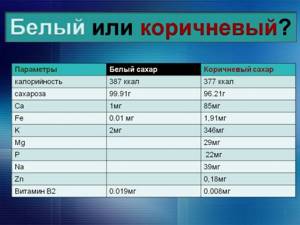
Indeed, the calorie content of this product will differ from that of the white species. But 100 grams contains 378 calories, and the difference actually turns out to be insignificant. Therefore, if you replace one variety with another, there will be no significant difference in weight loss due to the same number of calories.
Calorie content of sweeteners
Some sweet lovers who cannot completely give up sugar prefer to choose sweeteners. There are varieties of natural and synthetic origin. Natural ones include fructose, sorbitol, xylitol.
| Sweetener | Energy value |
| fructose | 375 kcal |
| sorbitol | 354 calories |
| xylitol | 367 calories |
According to the table, the nutritional value of sweeteners is almost the same as that of the natural product. The group of synthetic sweeteners includes saccharin, aspartame, sucralose, sodium cyclamate.
The calorie content of such substances is zero. Therefore, people choose such products in order to fight excess weight. Plus, sweeteners do not cause destructive harm to tooth enamel and do not provoke the development of caries.
Important: Despite the fact that they are zero calorie, they promote overeating. The thing is that when eating them, the human body does not feel full.
Therefore, he eats much more products with synthetic sweeteners. Another disadvantage of such products is that they contain harmful substances that provoke the development of cancer, allergies, kidney failure and many other side effects.
How many calories are in a spoonful of cane sugar?
Likewise, if you measure the calorie content of cane powder in tablespoon or teaspoon volumes, the numbers will be approximately the same as for white. There are 75 kcal per 20 g tablespoon, and 19-26 kcal per teaspoon. Reed has approximately the same ratio of BPJU, but a richer mineral composition than white.
Cane product should under no circumstances be considered dietary and should not be used in the fight against obesity. Excessive consumption of cane sand and its calories will cause the same harm to the body as the use of its analogues.
We recommend reading the article on how to give up sweets.

Daily sugar intake for women and men
In accordance with WHO standards, the percentage of calories that enter the body with sugar should be no more than 10% of the total. For men, this sweetener norm is up to 9 teaspoons, for women – 6.

But this number needs to take into account more than just the number of teaspoons of sweetener that have been added to drinks or certain dishes. You need to count the amount of sweetener in all food eaten per day. For example, a glass of a sweet carbonated drink with some sweets can pay for the entire daily requirement in one go.
This is interesting! American researchers were able to calculate that the average US resident eats 190 g of sweetener daily. In Russia, the statistics are different, where the number is 100 g of granulated sugar per day per average resident.
Calorie table for second courses
Lunch should be the most satisfying meal of the day, but moderate in calories. The category of “highest fat and high-calorie dishes” listed in the table includes fried pork cutlets, breaded chicken and fish, and fast food from McDonald’s.
Calorie table for second courses
When calculating the calorie content of ready-made dishes, do not forget that meat, fish and seafood contain water (especially when frozen), which increases the volume of the food. When cooked, meat loses from 15 to 40% of its original weight. Weight loss depends on the time and type of heat treatment. As for the ratio of fats and proteins in boiled and raw meat, it also does not remain unchanged.
Benefits and harms
Sugar powder is an easily digestible carbohydrate with a high calorie content that charges the human body with energy. Sucrose is broken down into glucose and fructose. Glucose becomes a participant in the synthesis of sulfuric acid, activates internal organs, promotes the production of insulin and hormones of happiness and joy. If we consider the biological nutritional value and calorie content of white carbohydrate, then its fat and protein content is zero. Excessive sugar consumption can lead to obesity, the development of caries and other dental problems, and calcium and mineral deficiency in the body.
How many calories are in one tablespoon of granulated sugar?
How hard it is to be a girl... Practically, we all have a big sweet tooth, and all sweets are very high in calories, which cannot but affect our figures. Unfortunately, modern society has introduced a fashion for thin young ladies. Therefore, in order to meet them, you have to exhaust yourself with long workouts, strict diets, and giving up sweets, especially sugar. After all, sugar is considered one of the most high-calorie foods.
100 g contains 398 calories of this product.
Let's calculate how much sugar can be contained in 1 tablespoon?
Let's round up 398 calories to 400, it will be easier to count.
1 tbsp. = 18 g - also for convenience, round up to 20 g.
100 g: 20 g = 5 tbsp. sugar is contained in 100 g, respectively,
400 cal. : 5 = 80 cal. contained in 1 tbsp. Sahara. WOW!
80 cal. – this is 700 g of cucumbers, or 500 g of tomatoes, or 400 g of cabbage, or 350 g of mushrooms, or 300 g of eggplant, or 250 g of lemon, or 250 g of kefir, or 200 g of watermelon, or 1 ,5 eggs, . or 1 small tablespoon of sugar.
